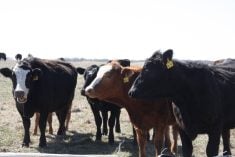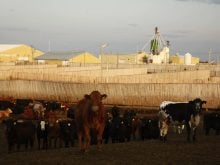This cattle market information is selected from the weekly report from Canfax, a division of the Canadian Cattlemen’s Association. More market information, analysis and statistics are available by becoming a Canfax subscriber by calling 403-275-5110 or at www.canfax.ca.
Fed prices drop
Sharply lower U.S. cash prices, dropping beef cutouts, falling Chicago cattle futures, seasonally slow beef sales and heavier than usual American carcass weights pressured Canadian cattle prices sharply lower.
Dressed trade was $7.50-$10 per hundredweight lower in a range of $280-$290 delivered in Alberta and Saskatchewan.
Read Also

VIDEO: Ag in Motion documentary launches second season
The second season of the the Western Producer’s documentary series about Ag in Motion launched Oct. 8.
There was little live trade. The Canfax fed steer average was $169.67 per cwt., down about $6, and the heifer average was $168.61, down about $10.50.
Carcass weights are also increasing in Western Canada and while discounts for heavy cattle have yet to develop here, they likely will appear soon. They did contribute to the wide trading range.
The cash-to-futures basis re-mains seasonally strong but weakened last week to -$7.49.
Weekly western Canadian fed slaughter to Sept. 19 was 41,079 head, the biggest kill this year.
Packers have a comfortable supply and feedlots are under pressure to manage weights.
Cow prices lower
Alberta D1, D2 cow prices are within pennies of the lows set in early January, while Ontario prices are at the lowest levels seen this year.
D1, D2 cows ranged $124-$142 to average $131.50 and D3 cows ranged $112-$125 to average $119.
Rail grade cows were $250 to $255.
Western Canadian cow slaughter is ranging from 4,000 to 4,500 head a week. That is a bit slow, and more cows are going to U.S. slaughter.
In the past two years, D1, D2 cow prices rose from September to October, but that likely won’t be the case this year because of struggling fed prices and a weak trim market.
Prices are anticipated to find an annual low around $118-$122.
Feeder prices struggle
Chicago live cattle futures posted new lows last week, and feeder cattle declined more than seven percent over two weeks.
On a continuous chart, feeder futures were at the lowest levels since May 2014.
In Canada, cash and forward calf prices last week fell $10 per cwt. and yearlings closed the week $5 lower.
Saskatchewan steer calf prices appear to be at a slight premium over Alberta values, which reflects Manitoba, Ontario and Quebec de-mand and Saskatchewan’s freight advantage over Alberta on animals going east.
However, there are reports in the yearling market of Saskatchewan and Manitoba yearlings going to Alberta.
A few exposed heifers are appearing at market, which is unusual for this time of year. Most exposed females are entering feed yards.
Electronic sales have made up about half the total auction volumes in Alberta over the past three weeks.
Prices for all classes of Canadian feeders remain above year-ago levels, but the U.S. feeder index is trading at the lowest levels in more than a year.
This is affecting export demand.
Beef falls
U.S. boxed beef prices to Sept. 24 fell hard with Choice down US$15.65 at $214.85 per cwt. and Select down $10.08 at $211.62.
Lower prices encouraged beef movement.
The cutout has dropped $23-$30 in the last six weeks. Prices should improve in the fourth quarter once fed cattle supplies tighten and holiday beef demand appears.
Weekly Canadian boxed beef prices to Sept. 18 saw AAA down C$6.76 at $292.13 cwt. and AA down $5.60 at $285.33.
The Montreal wholesale price fell to $325-$328.
















